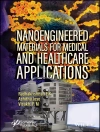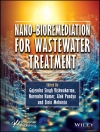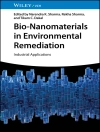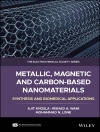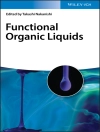Presents novel, nanotechnology-based solutions for urgent environmental engineering problems
Clear and concise from beginning to end, this book focuses on the design and application of artificially intelligent nanomaterials, which help in solving many tangible environmental problems?especially water and air pollution. It lays out the design concepts, major chemical principles, and materials considerations of artificially intelligent nanomaterials for environmental engineering, and provides proof-of-concept examples such as improved filtration membranes, nanofibrous air filters, and molecularly imprinted nanomaterials.
Artificially Intelligent Nanomaterials: For Environmental Engineering starts by describing the background of environmental nanotechnology, the rise of Artificial Intelligence (AI), and the current status of AI in environmental engineering. It then looks at: intelligently functional materials and responsive mechanisms; designing filtration membranes with responsive gates; switchable wettability materials for controllable oil/water separation; and self-healing materials for environmental applications. The book continues with chapters that examine: emerging nanofibrous air filters for PM2.5 removal; self-propelled nanomotors for environmental applications; molecular imprinting in wastewater treatment; and emerging synergistically multifunctional and all-in-one nanomaterials and nanodevices in advanced environmental applications.
-Presents the state-of-the-art in environmental technology and puts forward bold ideas for its advancement
-Addresses global challenges, including all important water and air quality which are critical for human health and a sustainable future
-Concentrates on nanotechnology-enabled solutions for pollutant removal from water and air
Artificially Intelligent Nanomaterials: For Environmental Engineering is an ideal book for undergraduates, graduates, scientists, and professionals in the fields of environmental science, material science, chemistry, and chemistry engineering.
Mục lục
Preface xi
1 Introduction 1
1.1 Global Challenges 1
1.2 Conventional Technologies in Environmental Science and Engineering 2
1.3 Nanotechnology 3
1.3.1 History of Nanotechnology Evolution 3
1.3.2 Concept and Definition 4
1.3.3 Fields of Current Applications 4
1.3.4 Nanotechnology in Environmental Engineering 5
1.4 Artificially Intelligent Materials 7
1.4.1 Artificial Intelligence (AI) and Nanotechnology 7
1.4.2 Examples of Artificially Intelligent Nanomaterials 7
1.4.2.1 Energy Nanogenerator/Nanosensor (Piezoelectric/Triboelectric Materials) 7
1.4.2.2 Shape-Memory Materials 8
1.4.2.3 Actuator 9
1.5 Intelligent Environmental Nanomaterials 11
1.5.1 Overview 11
1.5.2 Self-Propelled Nanomotors 12
1.5.3 Intelligent Gating Membrane 12
1.5.4 Switchable Oil/Water Separation 12
1.5.5 Self-Healing Environmental Materials 12
1.5.6 Molecular Imprinting 13
1.5.7 Nanofibrous Membrane Air Filters 13
1.6 Introduction to the Book Chapters 13
References 14
2 Fundamental Mechanisms of Intelligent Responsiveness 27
2.1 Overview of Intelligent Responsiveness 27
2.2 Responsiveness in the Polymer System 28
2.3 Thermoresponsiveness 29
2.3.1 LCST Thermoresponsiveness 30
2.3.2 UCST Thermoresponsiveness 32
2.3.2.1 Coulomb Interaction-Induced UCST Polymers (Polyzwitterions) 32
2.3.2.2 Hydrogen Bonding-Induced UCST Polymers 33
2.4 p H Responsiveness 34
2.4.1 p H-Responsive Basic Polymers 36
2.4.2 p H-Responsive Acidic Polymers 38
2.5 Photo-responsiveness 39
2.5.1 Azobenzene and Its Derivatives 41
2.5.2 Spiropyran-Based Polymers 42
2.5.3 Inorganic Photo-Responsive Materials 42
2.6 Metalic Ion Responsiveness 43
2.6.1 Poly(NIPAM-co-AAB18C6) 44
2.6.2 Poly(NIPAM-co-AAB15C5) (15-Crown-5) 45
2.7 Ion Strength Responsiveness 45
2.8 Redox Responsiveness 47
2.9 Multi-responsiveness 49
2.9.1 Dual Stimuli-Responsive Polymers 49
2.9.1.1 Thermo- and Photo-Responsive Polymers 49
2.9.1.2 Thermo- and p H-Responsive Polymers 49
2.9.1.3 Thermo- and Redox-Responsive Polymers 50
2.9.2 Multi-Stimuli-Responsive Polymers 50
2.9.2.1 Thermo-, Photo-, and p H-Responsive Polymers 50
2.9.2.2 Thermo-, Photo-, and Redox-Responsive Polymers 51
2.10 Conclusion 52
References 52
3 Filtration Membranes with Responsive Gates 69
3.1 Membrane Separation for Water Purification and Desalination 69
3.2 Emerging Design and Concept of Filtration Membranes with Responsive and Intelligent Gates 70
3.3 Fabrication Methods of Intelligent Gating Membranes 71
3.3.1 Post-Modification Method 72
3.3.2 One-Step Formation Method 73
3.4 Application of Intelligent Gating Membranes to Environmental Separation 73
3.5 Thermoresponsiveness 74
3.6 p H Responsiveness 80
3.6.1 Polybase Gating Membranes 80
3.6.2 Polyacid Gating Membrane 83
3.7 Photo-responsiveness 85
3.7.1 Azobenzene-Based Gating Membranes 85
3.7.2 Spiropyran-Based Gating Membranes 87
3.8 Metallic Ion Responsiveness 89
3.9 Redox Responsiveness 91
3.10 Ion Strength Responsiveness 92
3.11 Dual and Multi-Stimuli Responsiveness 95
3.11.1 p H and Temperature Dual Responsiveness 95
3.11.2 Temperature and Ion Strength Dual Responsiveness 97
3.11.3 p H and Ion Strength Dual Responsiveness 97
3.11.4 Temperature, p H, and Ion Strength Multi-responsiveness 99
3.12 Conclusions 99
References 100
4 Switchable Wettability Materials for Controllable Oil/Water Separation 113
4.1 Oil Spill Treatment 113
4.2 Fundamentals of Special Wettability 114
4.2.1 Surface Wetting Properties 114
4.2.2 Liquid Wettability in Air 115
4.2.3 Oil Wettability Underwater 117
4.3 Special Wettable Materials for Oil/Water Separation 118
4.4 Switchable Oil/Water Separation 120
4.5 Surface Chemistry Behind Stimuli-Responsive and Switchable Wettability 121
4.6 Temperature Responsiveness 121
4.7 p H Responsiveness 126
4.7.1 Pyridine-Based System 126
4.7.2 Carboxyl-Based System 129
4.7.3 Tertiary Amine-Based p H-Responsive Systems 131
4.8 Photo-responsiveness 132
4.8.1 Inorganic Photo-responsive Materials 133
4.8.2 Organic Photo-responsive Materials 135
4.9 Gas, Solvent, Ion, and Electric Field Responsiveness 136
4.9.1 Gas Responsiveness 136
4.9.2 Solvent Responsiveness 139
4.9.3 Ion Responsiveness 140
4.9.4 Electric Field Responsiveness 141
4.10 Dual/Multi-stimuli 143
4.11 Conclusion 143
References 145
5 Self-Healing Materials for Environmental Applications 157
5.1 Biomimetic Self-Healing Materials 157
5.2 Overview of Self-Healing Materials 158
5.3 Extrinsic and Intrinsic Self-Healing Materials 159
5.3.1 Extrinsic Self-Healing Materials 159
5.3.2 Intrinsic Self-Healing Materials 160
5.4 Self-Healing Materials in Environmental Applications 162
5.4.1 Self-Healing of Physical Cracks 163
5.4.2 Self-Restoring of Surface Functional Components 171
5.4.2.1 Chemical Mechanism 171
5.4.2.2 Hydrophobic Self-Healing 172
5.4.2.3 Hydrophilic Self-Healing 174
5.4.3 Self-Cleaning of Contaminated Surfaces 176
5.4.3.1 Superhydrophobicity-Induced Self-Cleaning 176
5.4.3.2 Superhydrophilicity-Induced Self-Cleaning 178
5.4.3.3 Photocatalytic Self-Cleaning 181
5.5 Conclusion 183
References 185
6 Emerging Nanofibrous Air Filters for PM2.5 Removal 197
6.1 Particulate Matter 197
6.2 Traditional Technology 198
6.3 Nanofibrous Membrane Air Filters 199
6.3.1 Filtration Mechanism 199
6.3.2 Fabrication Methods 200
6.4 Applications 201
6.4.1 Transparent Air Filter 202
6.4.2 Air Filter for High Thermal Stability 203
6.4.3 Air Filter for Thermal Management 204
6.4.4 Air Filter for Mass Production 206
6.4.5 Self-Powered Air Filter 206
6.4.6 Nanofibrous Air Filter for the Simultaneous Removal of PM and Toxic Gases 208
6.4.7 Nanofibrous Air Filter with Antibacterial Functions 212
6.4.8 Air Filtration and Oil Removal 214
6.5 Conclusion 216
References 216
7 Intelligent Micro/Nanomotors in Environmental Sensing and Remediation 227
7.1 Self-Propelling Mechanism of Micro/Nanomotors 228
7.1.1 Self-Electrophoretic Mechanism 228
7.1.2 Microbubble Propulsion Mechanism 229
7.1.3 Self-Diffusiophoresis Propulsion Mechanism 230
7.1.4 External Field-Driven Micro/Nanomotors 231
7.2 Self-Propelled Micro/Nanomotors as Environmental Sensors 233
7.3 Self-Propelled Micro/Nanomotors for Enhanced Organic Contamination Degradation 241
7.4 Self-Propelled Micro/Nanomotors as Efficient Antibacterial Agents 245
7.5 Self-Propelled Micro/Nanomotors as Efficient Miniature Absorbent 248
7.5.1 Self-Propelled Micro/Nanomotors for the Removal of Oil Droplets 248
7.5.2 Self-Propelled Micro/Nanomotors for the Removal of Molecules or Ions 251
7.6 Conclusions 257
References 257
8 Molecular Imprinting Materials in Environmental Application 265
8.1 Introduction 265
8.2 Fundamental of MIT 266
8.2.1 Covalent and Noncovalent Imprinting 266
8.2.2 Essential Elements of Molecular Imprinting 268
8.2.2.1 Target Templates 268
8.2.2.2 Functional Monomers 269
8.2.2.3 Cross-Linkers 271
8.2.2.4 Porogenic Solvents 271
8.2.2.5 Initiators 271
8.2.3 Synthesis Methods of MIPs 271
8.2.3.1 Free Radical Polymerization 272
8.2.3.2 Sol–Gel Processes 273
8.3 Molecular Imprinting in Environmental Applications 273
8.3.1 Natural and Synthetic Dyes 273
8.3.2 Endocrine-Disrupting Compounds 274
8.3.3 Polycyclic Aromatic Hydrocarbons (PAHs) 277
8.3.4 Pharmaceuticals and Pesticide 277
8.3.5 Metal 281
8.4 Conclusion 285
References 285
9 Emerging Synergistically Multifunctional and All-in-One Nanomaterials and Nanodevices in Advanced Environmental Applications 299
9.1 Introduction 299
9.2 An All-in-One, Point-of-Use Water Desalination Cell 299
9.3 3D-Printed, All-in-One Evaporator for Solar Steam Generation 300
9.4 All-in-One Photothermic Driven Catalysis and Desalination of Seawater Under Natural Sunlight 301
9.5 All-in-One Design of Water Harvesting from Air Powered by Natural Sunlight 302
9.6 All-in-One Textile for Personal Thermal Management 304
9.7 Conclusion 305
References 305
Index 309
Giới thiệu về tác giả
Peng Wang is Full Professor of Environmental Science and Engineering at the Water Desalination and Reuse Center of the King Abdullah University of Science and Technology (KAUST), Saudi Arabia.
Jian Chang, Master, is currently a research technician in Professor Peng Wang’s group at KAUST.
Lianbin Zhang is Full Professor of School of Chemistry and Chemical Engineering at Huazhong University of Science and Technology, China.


